Computation of bounds elastic properties of polycrystals based on fast fourier transform method
An alternative approach to Finite Element Method (FEM) has been proposed in the
middle of the nineties by Moulinec and Suquet [1] for the computation of the effective
properties of linear elastic periodic composites. The unit cell problem is solved by means
of an iterative scheme which uses the periodic Green’s tensor for the strain and could be
directly applied to digital images which come from microstructure. The main advantages
of this approach over the FEM is that it does not require the introduction of a “high
dimension” stiffness matrix. The FFT methods only need the storage of tables whose
dimensions are the number of DoF (the FEM requires the storage of the rigidity matrix
whose dimension is the square of the DoF). The memory needed for solving the unit cell
problem with FFT methods is then significantly reduced. The FFT method allows to
expand the solution of the Lippmann-Schwinger equation into Neumann series, along the
lines of a method which was first introduced for composite conductors by Brown [2] and
later by Kroner [3]. The convergence of the method has been largely studied in the
literature particularly for the problems with high contrasts between the phase elastic
properties. Other formulation has been then provided to improve the convergence: the
(dual) stress based formulation in [4, 5] and the accelerated schemes in [6, 7, 8].
Accelerated schemes are not considered in the present study since the contrast in
polycrystal is sufficiently low to use the basic strain and stress based iterative schemes.
An alternative approach based on the shape functions has been developed by Bonnet [5]
to improve the FFT solutions. The close-form expressions of the shape functions are
available for inclusions having ellipsoidal shapes in the book of Nemat-Nasser [9], for
instance. Later, in [10], it has been proved that the use of the shape functions in the FFTbased iterative schemes provides rigorous bounds of the effective elastic properties of the
composites. More precisely, the strain and stress based FFT solutions deliver an upper and
lower bound respectively. The lower and upper bounds of the homogenized elastic
coefficients are computed by means of the FFT method combined with the use of the
shape functions. The microstructure of the polycrystal is generated by Voronoi
tessellations. The polycrystal is constituted of single crystal which are polygons (for 2D
problems) and polyhedrons (for 3D ones). The shape functions of the polygons and
polyhedrons have been recently provided in [11].
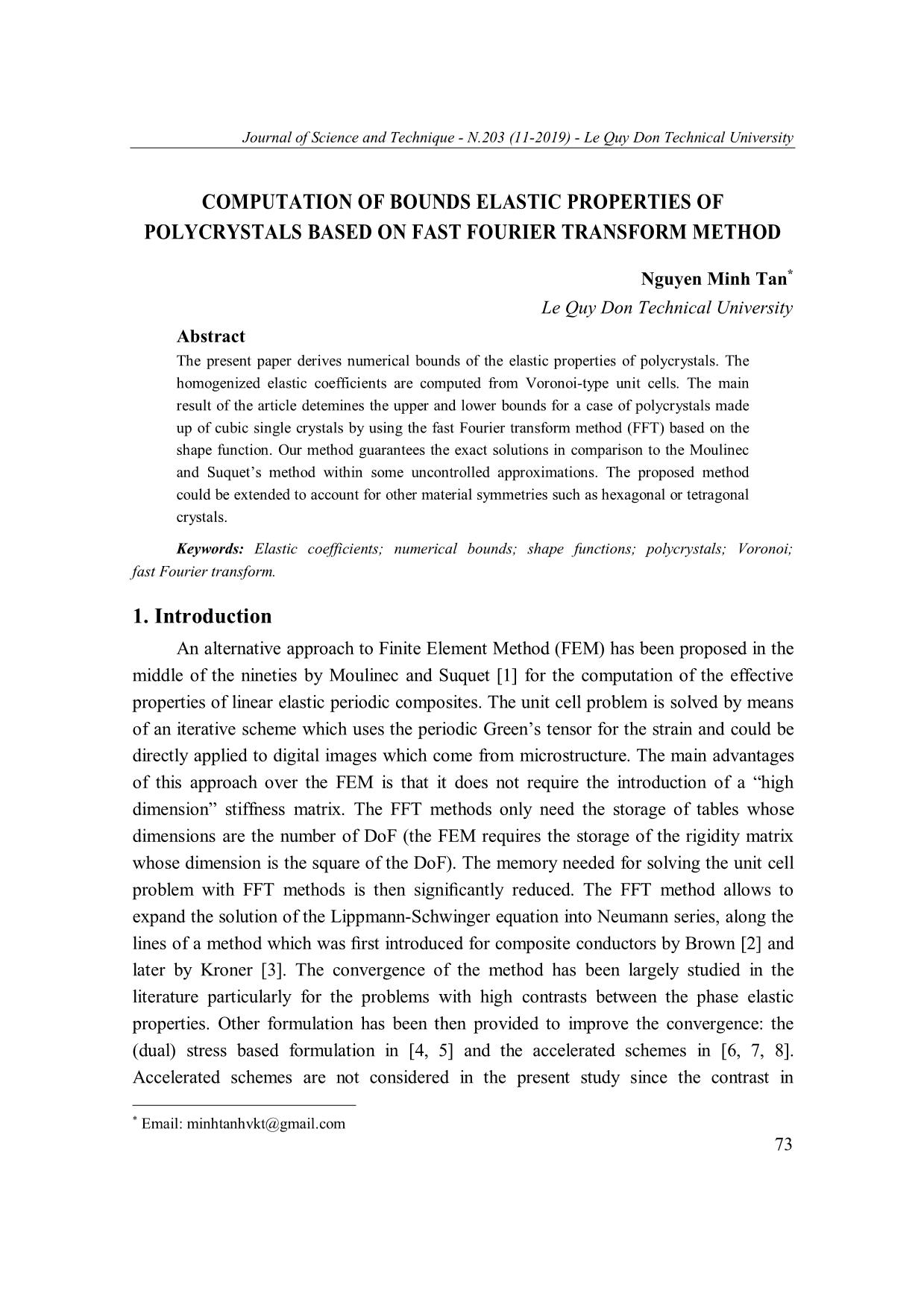
Trang 1
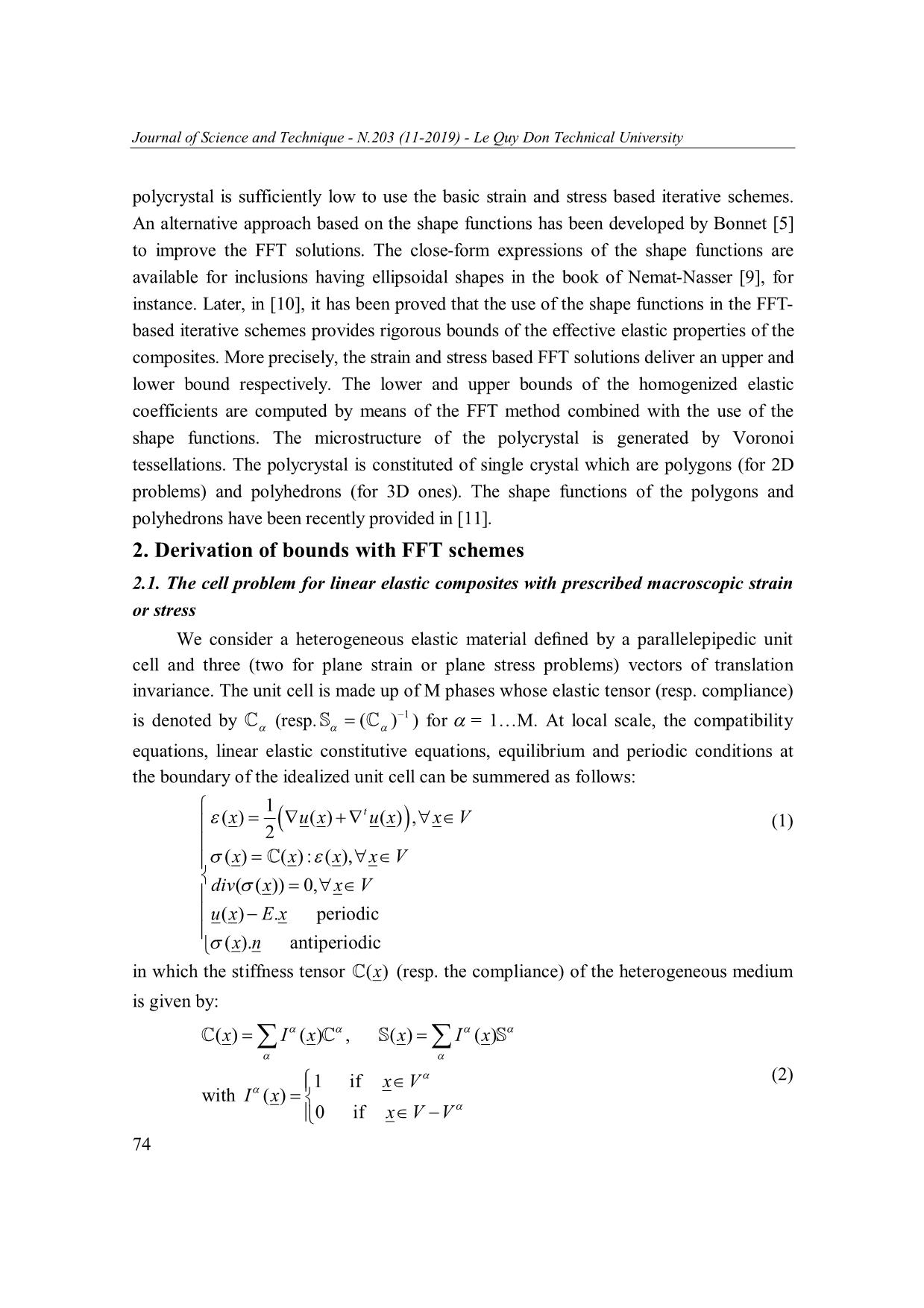
Trang 2
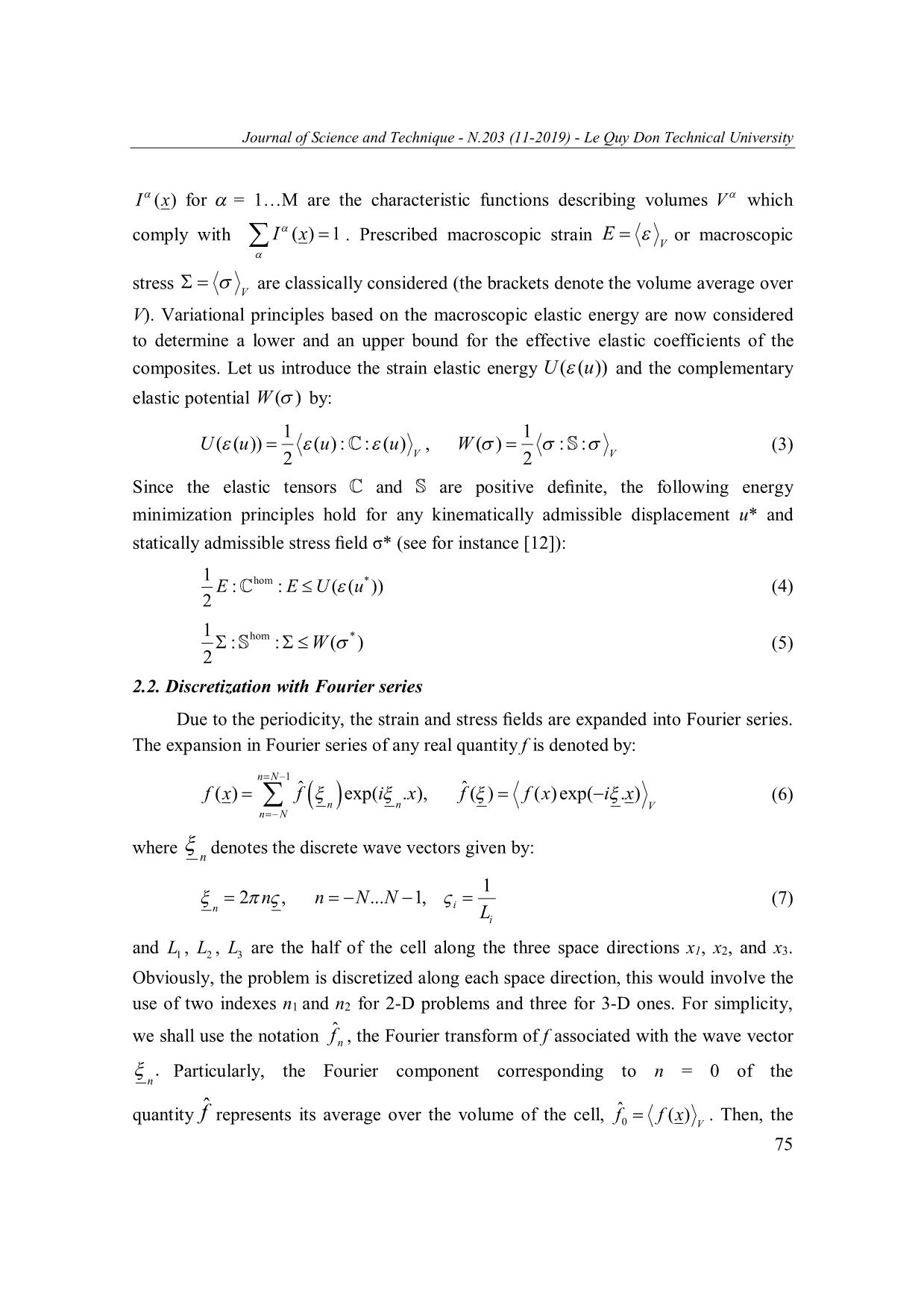
Trang 3
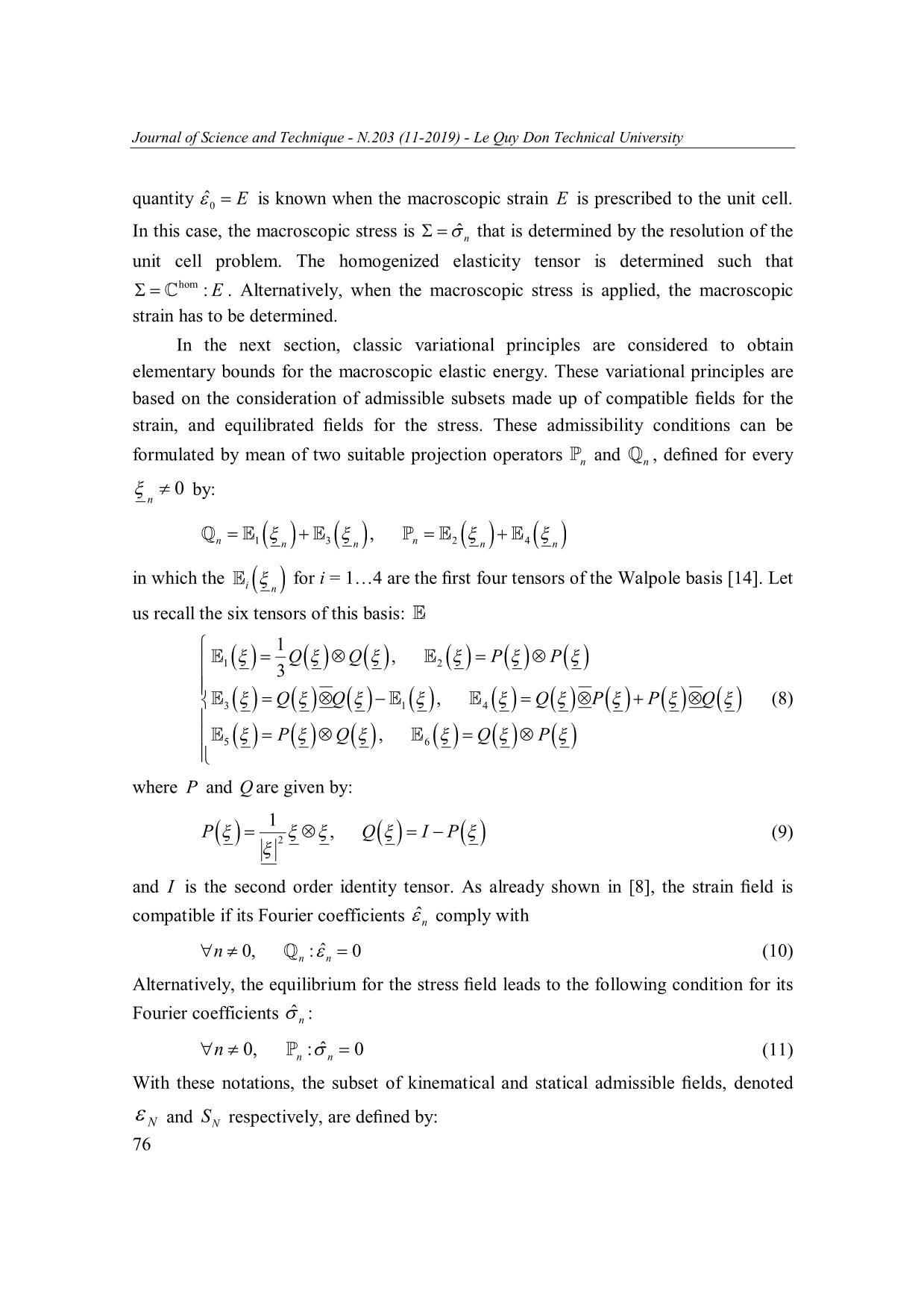
Trang 4
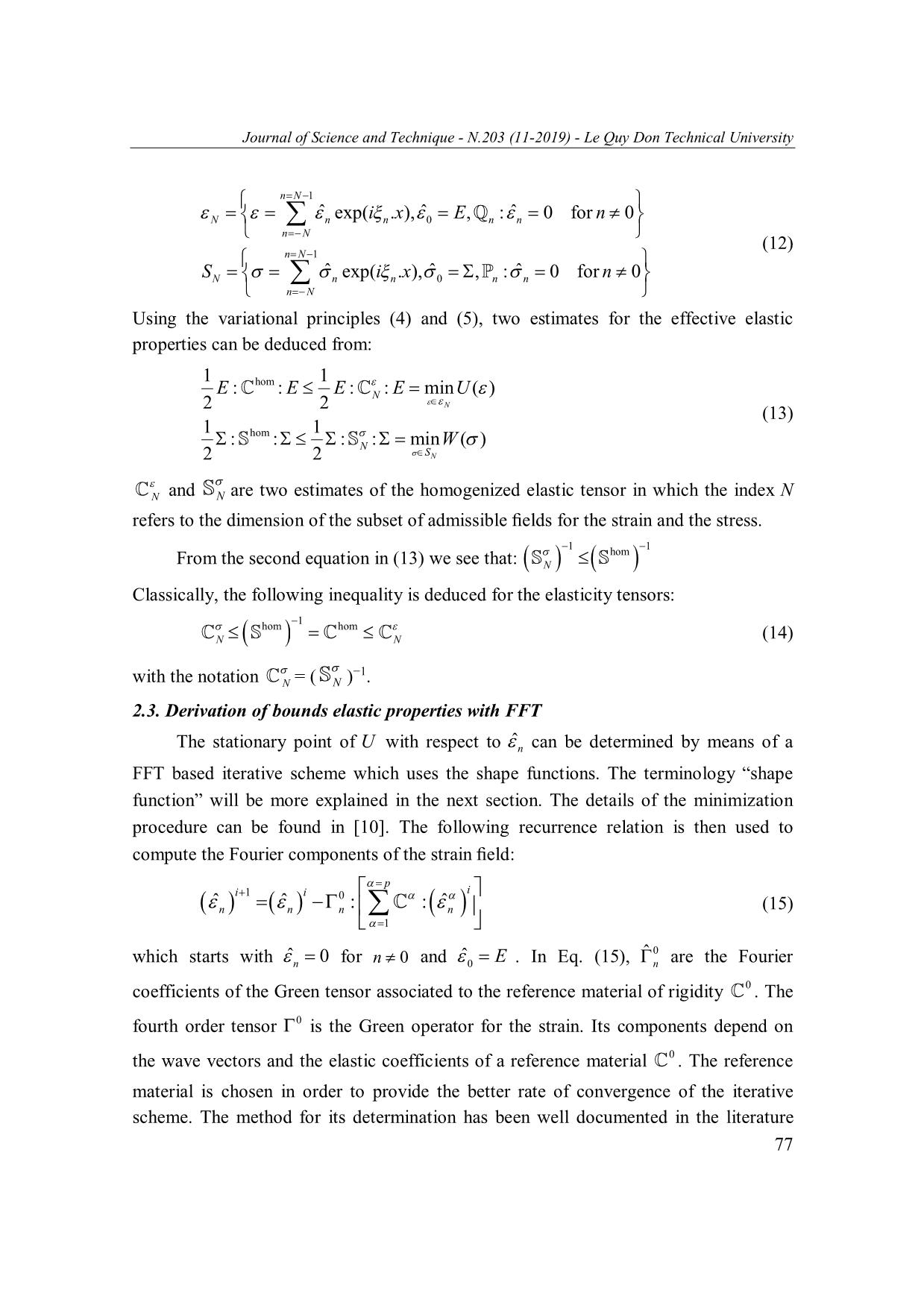
Trang 5
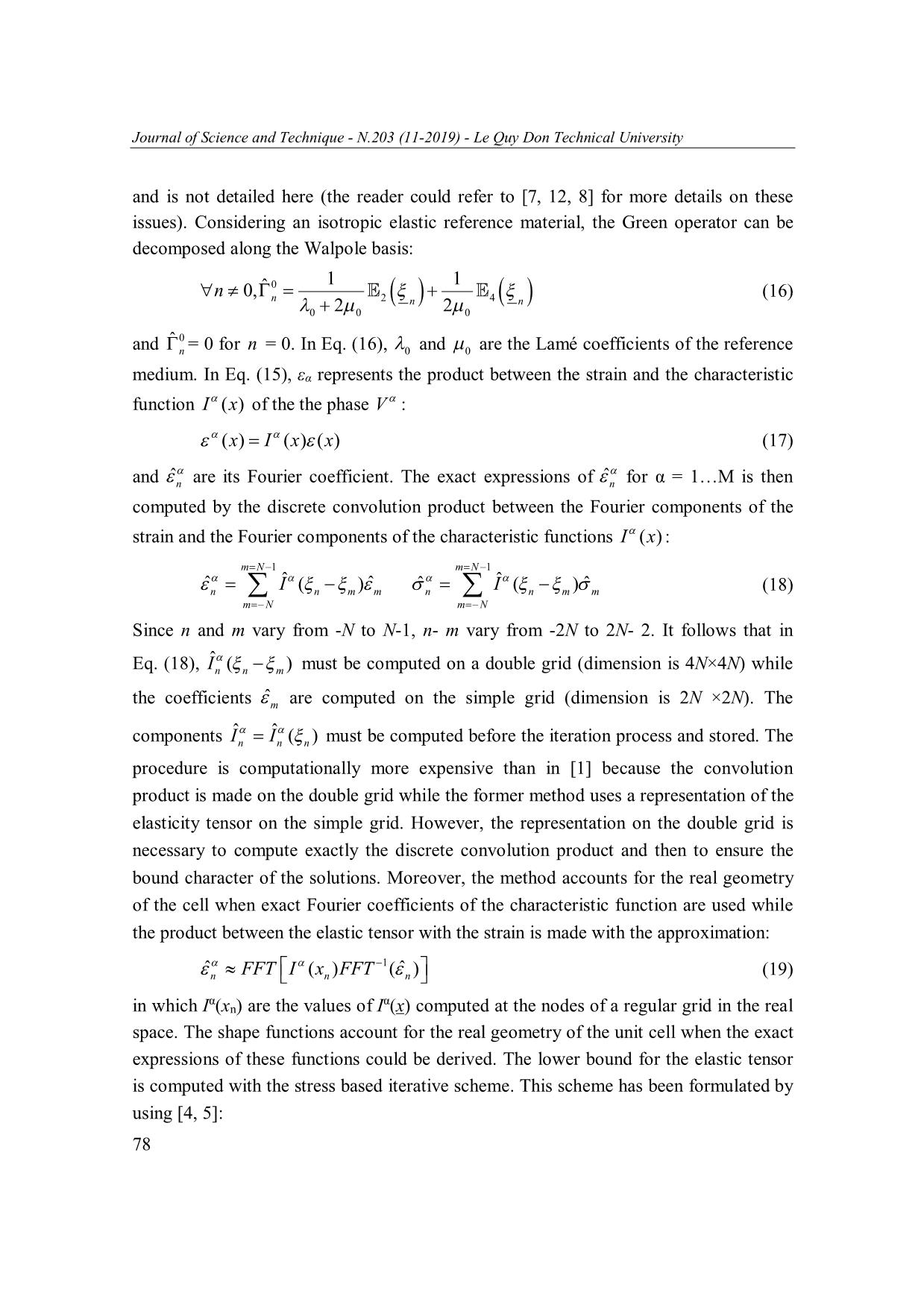
Trang 6
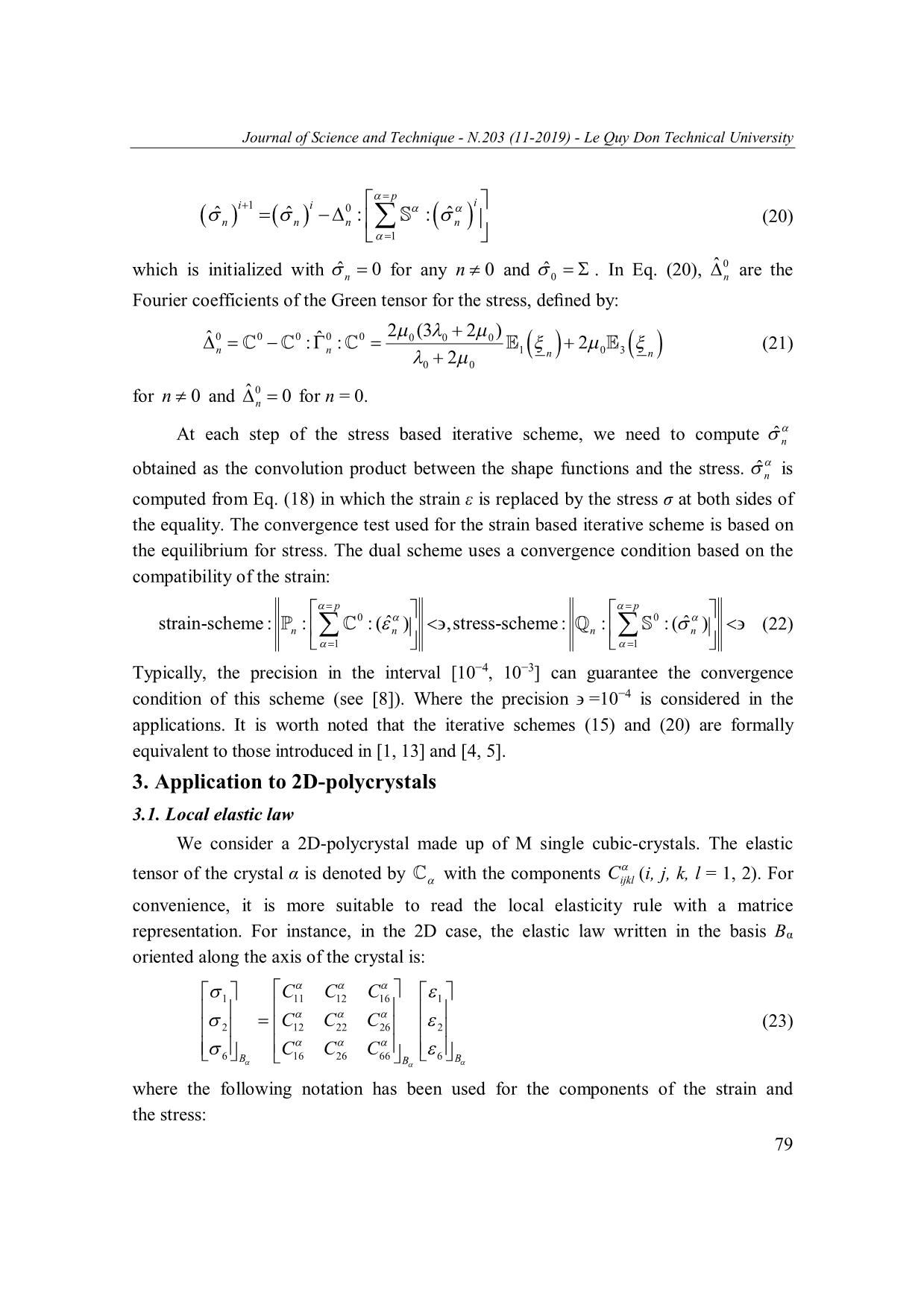
Trang 7
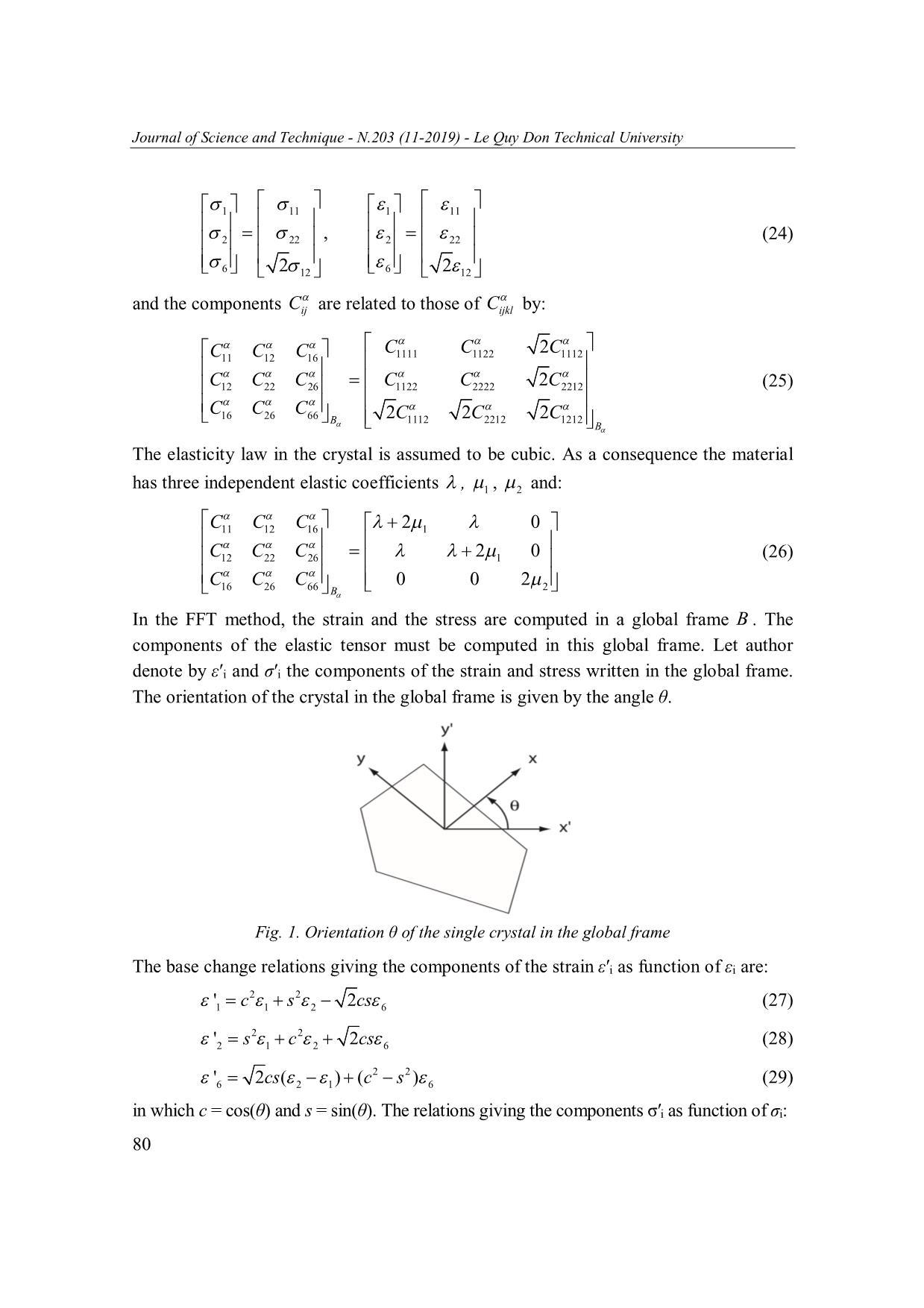
Trang 8
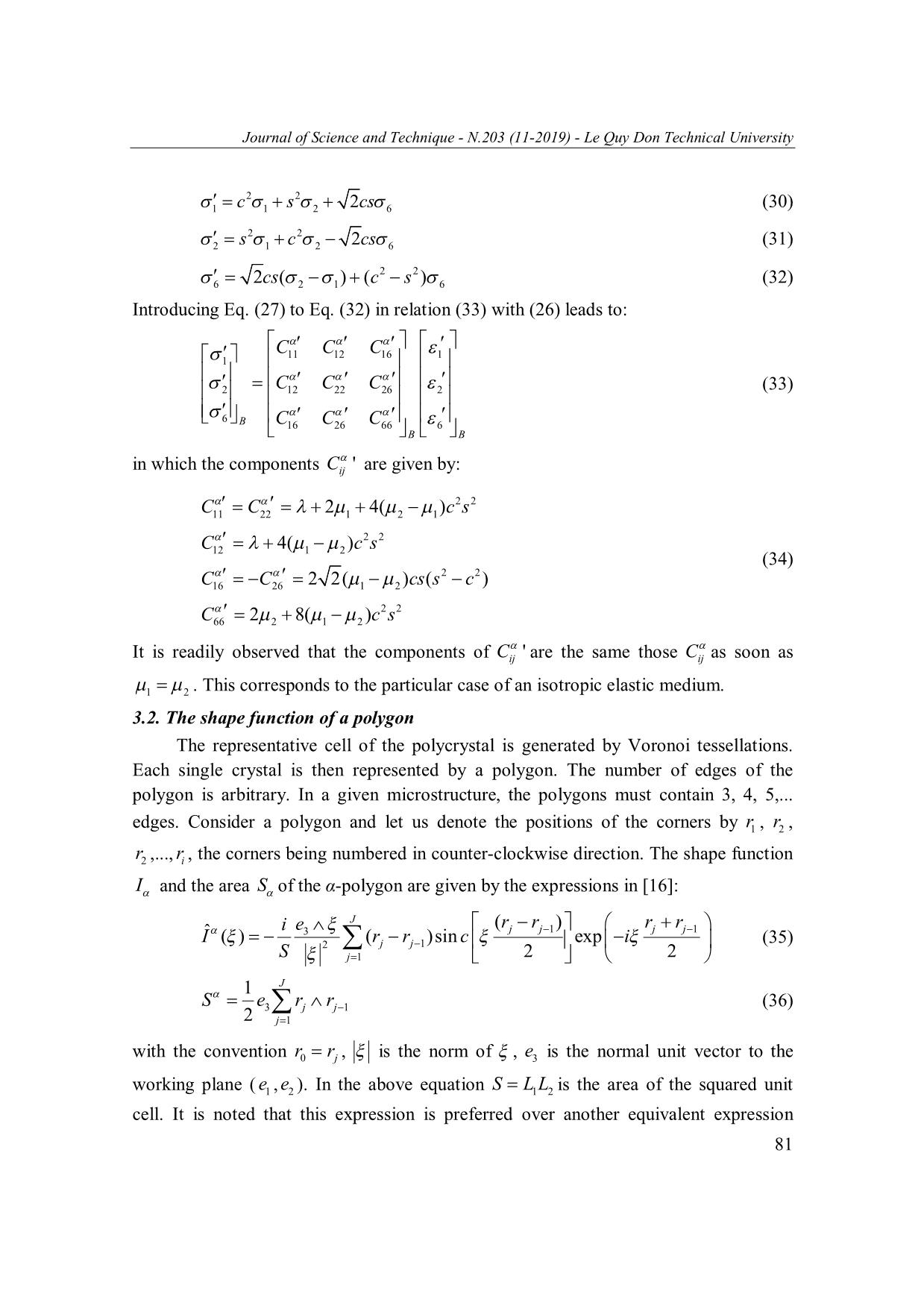
Trang 9
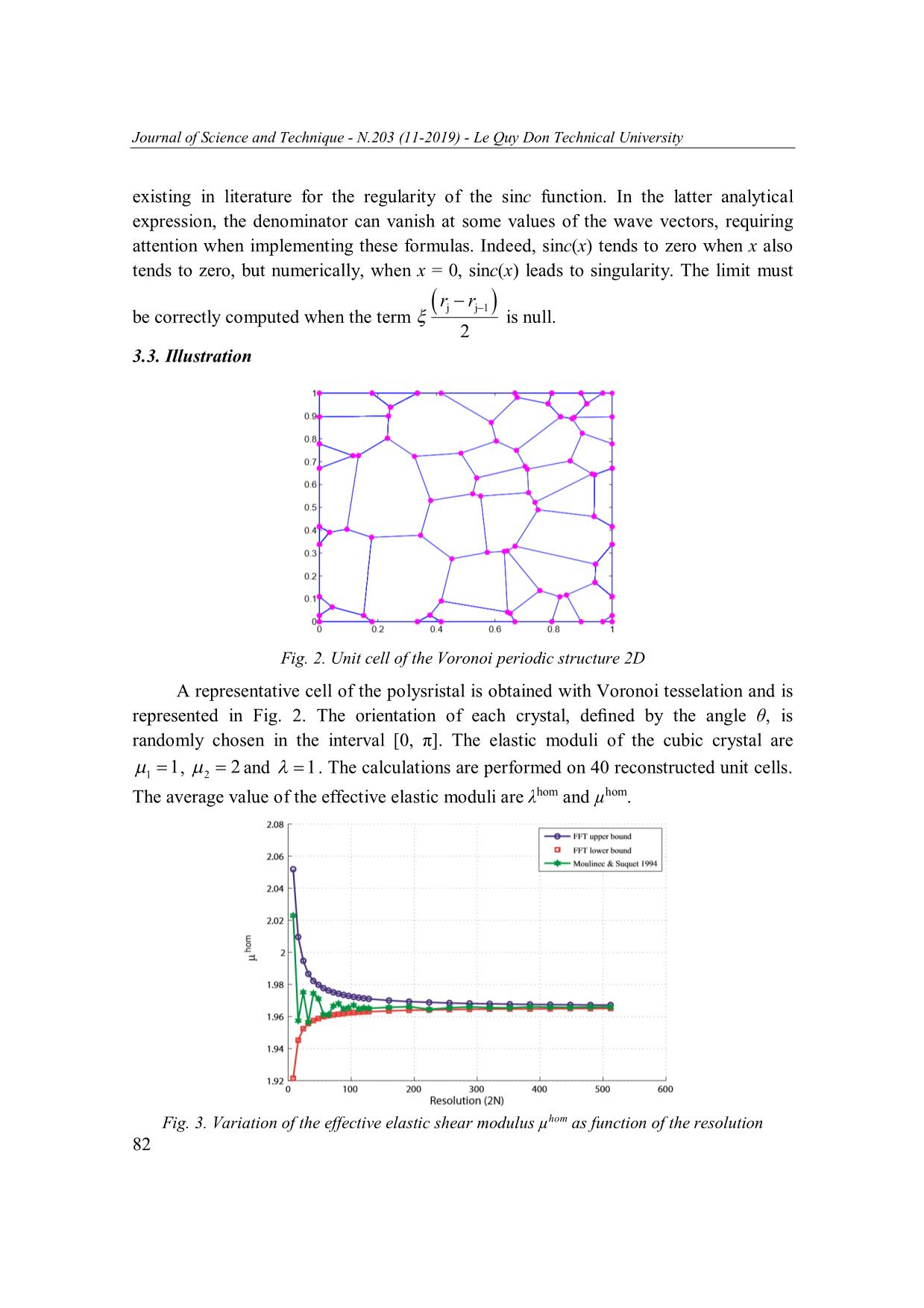
Trang 10
Tải về để xem bản đầy đủ
Tóm tắt nội dung tài liệu: Computation of bounds elastic properties of polycrystals based on fast fourier transform method
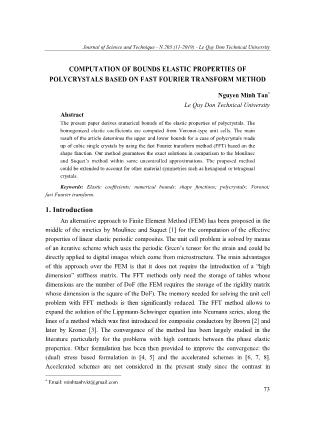
Journal of Science and Technique - N.203 (11-2019) - Le Quy Don Technical University COMPUTATION OF BOUNDS ELASTIC PROPERTIES OF POLYCRYSTALS BASED ON FAST FOURIER TRANSFORM METHOD * Nguyen Minh Tan Le Quy Don Technical University Abstract The present paper derives numerical bounds of the elastic properties of polycrystals. The homogenized elastic coefficients are computed from Voronoi-type unit cells. The main result of the article detemines the upper and lower bounds for a case of polycrystals made up of cubic single crystals by using the fast Fourier transform method (FFT) based on the shape function. Our method guarantees the exact solutions in comparison to the Moulinec and Suquet’s method within some uncontrolled approximations. The proposed method could be extended to account for other material symmetries such as hexagonal or tetragonal crystals. Keywords: Elastic coefficients; numerical bounds; shape functions; polycrystals; Voronoi; fast Fourier transform. 1. Introduction An alternative approach to Finite Element Method (FEM) has been proposed in the middle of the nineties by Moulinec and Suquet [1] for the computation of the effective properties of linear elastic periodic composites. The unit cell problem is solved by means of an iterative scheme which uses the periodic Green’s tensor for the strain and could be directly applied to digital images which come from microstructure. The main advantages of this approach over the FEM is that it does not require the introduction of a “high dimension” stiffness matrix. The FFT methods only need the storage of tables whose dimensions are the number of DoF (the FEM requires the storage of the rigidity matrix whose dimension is the square of the DoF). The memory needed for solving the unit cell problem with FFT methods is then significantly reduced. The FFT method allows to expand the solution of the Lippmann-Schwinger equation into Neumann series, along the lines of a method which was first introduced for composite conductors by Brown [2] and later by Kroner [3]. The convergence of the method has been largely studied in the literature particularly for the problems with high contrasts between the phase elastic properties. Other formulation has been then provided to improve the convergence: the (dual) stress based formulation in [4, 5] and the accelerated schemes in [6, 7, 8]. Accelerated schemes are not considered in the present study since the contrast in * Email: minhtanhvkt@gmail.com 73 Journal of Science and Technique - N.203 (11-2019) - Le Quy Don Technical University polycrystal is sufficiently low to use the basic strain and stress based iterative schemes. An alternative approach based on the shape functions has been developed by Bonnet [5] to improve the FFT solutions. The close-form expressions of the shape functions are available for inclusions having ellipsoidal shapes in the book of Nemat-Nasser [9], for instance. Later, in [10], it has been proved that the use of the shape functions in the FFT- based iterative schemes provides rigorous bounds of the effective elastic properties of the composites. More precisely, the strain and stress based FFT solutions deliver an upper and lower bound respectively. The lower and upper bounds of the homogenized elastic coefficients are computed by means of the FFT method combined with the use of the shape functions. The microstructure of the polycrystal is generated by Voronoi tessellations. The polycrystal is constituted of single crystal which are polygons (for 2D problems) and polyhedrons (for 3D ones). The shape functions of the polygons and polyhedrons have been recently provided in [11]. 2. Derivation of bounds with FFT schemes 2.1. The cell problem for linear elastic composites with prescribed macroscopic strain or stress We consider a heterogeneous elastic material defined by a parallelepipedic unit cell and three (two for plane strain or plane stress problems) vectors of translation invariance. The unit cell is made up of M phases whose elastic tensor (resp. compliance) 1 is denoted by (resp. () ) for = 1M. At local scale, the compatibility equations, linear elastic constitutive equations, equilibrium and periodic conditions at the boundary of the idealized unit cell can be summered as follows: 1 t ()()(),x u x u x x V (1) 2 (x ) ( x ) : ( x ), x V div( ( x )) 0, x V u( x ) E . x periodic (x ). n antiperiodic in which the stiffness tensor ()x (resp. the compliance) of the heterogeneous medium is given by: ()(),()()x I x x I x (2) 1 if x V with I ( x ) 0 if x V V 74 Journal of Science and Technique - N.203 (11-2019) - Le Quy Don Technical University I () x for = 1M are the characteristic functions describing volumes V which I ( x ) 1 E comply with . Prescribed macroscopic strain V or macroscopic ... convolution product and then to ensure the bound character of the solutions. Moreover, the method accounts for the real geometry of the cell when exact Fourier coefficients of the characteristic function are used while the product between the elastic tensor with the strain is made with the approximation: ˆ 1 ˆ n FFT I()() x n FFT n (19) α α in which I (xn) are the values of I (x) computed at the nodes of a regular grid in the real space. The shape functions account for the real geometry of the unit cell when the exact expressions of these functions could be derived. The lower bound for the elastic tensor is computed with the stress based iterative scheme. This scheme has been formulated by using [4, 5]: 78 Journal of Science and Technique - N.203 (11-2019) - Le Quy Don Technical University p i 1 i i ˆ ˆ0 ˆ n � n � n:: n ���� (20) 1 ˆ 0 which is initialized with ˆn 0 for any n 0 and ˆ0 . In Eq. (20), n are the Fourier coefficients of the Green tensor for the stress, defined by: 2 (3 2 ) � ˆ 0 0 0: ˆ 0 : 0 0 0 0 2 (21) n n 1 n 0 3 n 0 2 0 ˆ 0 for n 0 and n 0 for n = 0. At each step of the stress based iterative scheme, we need to compute ˆ n obtained as the convolution product between the shape functions and the stress. ˆ n is computed from Eq. (18) in which the strain ε is replaced by the stress σ at both sides of the equality. The convergence test used for the strain based iterative scheme is based on the equilibrium for stress. The dual scheme uses a convergence condition based on the compatibility of the strain: p p 0ˆ 0 ˆ �strain-scheme: n : :( n ) ,stress-scheme: n : :( n ) (22) 1 1 Typically, the precision in the interval [10−4, 10−3] can guarantee the convergence condition of this scheme (see [8]). Where the precision =10−4 is considered in the applications. It is worth noted that the iterative schemes (15) and (20) are formally equivalent to those introduced in [1, 13] and [4, 5]. 3. Application to 2D-polycrystals 3.1. Local elastic law We consider a 2D-polycrystal made up of M single cubic-crystals. The elastic tensor of the crystal α is denoted by with the components Cijkl (i, j, k, l = 1, 2). For convenience, it is more suitable to read the local elasticity rule with a matrice representation. For instance, in the 2D case, the elastic law written in the basis Bα oriented along the axis of the crystal is: 1 CCC 11 12 16 1 CCC (23) 2 12 22 26 2 CCC 6 BB 16 26 66 6 B where the following notation has been used for the components of the strain and the stress: 79 Journal of Science and Technique - N.203 (11-2019) - Le Quy Don Technical University 1 11 1 11 , (24) 2 22 2 22 6 212 6 2 12 and the components Cij are related to those of Cijkl by: CCC CCC1111 11222 1112 11 12 16 CCCCCC12 22 26 1122 22222 2212 (25) CCC16 26 66 2CCC 2 2 B 1112 2212 1212 B The elasticity law in the crystal is assumed to be cubic. As a consequence the material has three independent elastic coefficients , 1 , 2 and: CCC11 12 16 2 1 0 CCC 2 0 (26) 12 22 26 1 CCC16 26 66 0 0 2 2 B In the FFT method, the strain and the stress are computed in a global frame B . The components of the elastic tensor must be computed in this global frame. Let author denote by ε′i and σ′i the components of the strain and stress written in the global frame. The orientation of the crystal in the global frame is given by the angle θ. Fig. 1. Orientation θ of the single crystal in the global frame The base change relations giving the components of the strain ε′i as function of εi are: 2 2 '1 c 1 s 2 2 cs 6 (27) 2 2 '2 s 1 c 2 2 cs 6 (28) 2 2 '6 2cs ( 2 1 ) ( c s ) 6 (29) in which c = cos(θ) and s = sin(θ). The relations giving the components σ′i as function of σi: 80 Journal of Science and Technique - N.203 (11-2019) - Le Quy Don Technical University 2 2 1 c 1 s 2 2 cs 6 (30) 2 2 2 s 1 c 2 2 cs 6 (31) 2 2 6 2cs ( 2 1 ) ( c s ) 6 (32) Introducing Eq. (27) to Eq. (32) in relation (33) with (26) leads to: CCC11 12 16 1 1 CCC (33) 2 12 22 26 2 6 B CCC16 26 66 6 BB in which the components Cij ' are given by: 2 2 C11 C 22 2 1 4( 2 1 ) c s C 4( ) c2 s 2 12 1 2 (34) 2 2 C16 C 26 2 2( 1 2 ) cs ( s c ) 2 2 C66 2 2 8( 1 2 ) c s It is readily observed that the components of Cij ' are the same those Cij as soon as 1 2 . This corresponds to the particular case of an isotropic elastic medium. 3.2. The shape function of a polygon The representative cell of the polycrystal is generated by Voronoi tessellations. Each single crystal is then represented by a polygon. The number of edges of the polygon is arbitrary. In a given microstructure, the polygons must contain 3, 4, 5,... edges. Consider a polygon and let us denote the positions of the corners by r1 , r2 , r2 ,..., ri , the corners being numbered in counter-clockwise direction. The shape function I and the area S of the α-polygon are given by the expressions in [16]: J ()r r r r ˆ i e3 j j 1 j j 1 I( ) 2 ( rj r j 1 )sin c exp i (35) S j 1 2 2 J 1 S e3 rj r j 1 (36) 2 j 1 with the convention r0 rj , is the norm of , e3 is the normal unit vector to the working plane ( e1 , e2 ). In the above equation SLL 1 2 is the area of the squared unit cell. It is noted that this expression is preferred over another equivalent expression 81 Journal of Science and Technique - N.203 (11-2019) - Le Quy Don Technical University existing in literature for the regularity of the sinc function. In the latter analytical expression, the denominator can vanish at some values of the wave vectors, requiring attention when implementing these formulas. Indeed, sinc(x) tends to zero when x also tends to zero, but numerically, when x = 0, sinc(x) leads to singularity. The limit must rj r j 1 be correctly computed when the term is null. 2 3.3. Illustration Fig. 2. Unit cell of the Voronoi periodic structure 2D A representative cell of the polysristal is obtained with Voronoi tesselation and is represented in Fig. 2. The orientation of each crystal, defined by the angle θ, is randomly chosen in the interval [0, π]. The elastic moduli of the cubic crystal are 1 1, 2 2 and 1. The calculations are performed on 40 reconstructed unit cells. The average value of the effective elastic moduli are λhom and µhom. Fig. 3. Variation of the effective elastic shear modulus µhom as function of the resolution 82 Journal of Science and Technique - N.203 (11-2019) - Le Quy Don Technical University The variations of the homogenized elastic shear modulus with the number of wave vectors are provided in Fig. 3. Three solutions are provided in this figure, the strain and the stress based FFT bounds computed with the shape functions, the solution obtained with the original FFT iterative scheme of Moulinec and Suquet [1] without using the shape function. It is observed that the bounds have a uniform convergence and the solution of obtained with the original scheme of Moulinec and Suquet is comprised between the two bounds. 4. Extension to 3D-polycrystals In this section, we propose to extend the method based on the shape function to the case of 3D polycrystals. 4.1. The shape function of a polyhedron Each crystal of the 3D-polycrystal is represented by a polyhedron. It is defined by its K faces denoted Γk for k = 1...K. Each face Γk is a Jk-polygon given by the simple polygonal vertex chain rk ,1 ;...; rk, j and by the normal unit vector nˆk pointing towards the outside of the polyhedron. The shape function of the α-polyhedron is 0 K ˆ ˆ i .nk I ()() 2 k (37) V k 1 where V denotes the volume of the unit cell and J nˆk ()rk, j r k , j 1 r k , j r k , j 1 k( ) i ( r k, j r k , j 1 )sin c exp i (38) .qk . j 1 2 2 where the convention rk,0 r k , j must be used. The two order tensor qk is the projector onto the plane normal to the unit vector nˆk : qk I nˆ k n ˆ k (39) Note that k () is the 2D-shape function of the polygon k without the area S of the 2D unit cell. Indeed, when the polygon if embedded in a squared unit cell, the shape function is k ()/ S where S denotes the area of the unit cell. The volume of a polyhedron can be conveniently computed from: i KJ ˆ ˆ V nk( r k, j 1 r k , j )( n k r k , j ) (40) 6 k 1 j 1 4.2. Numerical Analysis The homogenized elastic coefficients of the polycrystal are now computed with the method based on the shape functions. A unit cell of the polycrystal is shown in Fig. 4. 83 Journal of Science and Technique - N.203 (11-2019) - Le Quy Don Technical University The cell contains 60 single cubic crystals. The orientation of each crystal is given by the three Euler angles θ1, θ2 and θ3 randomly chosen in the interval [0, π]. Fig. 4. Unit cell of the 3D-polycrystal (60 single crystals) The effective shear modulus and effective compressibility with the number of wave vectors are presented in Fig. 5 and Tab. 1. The result shows that the Moulinec and Suquet solution is again between the two bounds. Tab. 1. Average values of the effective shear modulus and effective compressibility computed for the 3D-polycrystal as function of the resolution. Comparison between the lower bound (LB) and the upper bound (UB) and the solutions obtained with the orifinal scheme of Moulinec and Suquet (M&S) µhom khom Resolution UB LB M&S UB LB M&S 4x4x4 1.5202 1.4705 1.4999 1.7187 1.7149 1.7178 8x8x8 1.5092 1.4877 1.4953 1.7202 1.7150 1.7195 16x16x16 1.5041 1.4904 1.4946 1.7207 1.7151 1.7203 32x32x32 1.5016 1.4913 1.4941 1.7211 1.7153 1.7207 64x64x64 1.5001 1.4916 1.4938 1.7212 1.7156 1.7209 96x96x96 1.4992 1.4924 1.4937 1.7212 1.7156 1.7210 128x128x128 1.4983 1.4927 1.4935 1.7213 1.7153 1.7211 256x256x256 1.4975 1.4934 1.4934 1.7213 1.7154 1.7211 84 Journal of Science and Technique - N.203 (11-2019) - Le Quy Don Technical University 1.6 FFT upper bound FFT lower bound 1.55 Moulinec & Suquet 1994 1.5 1.45 hom 1.4 1.35 1.3 0 50 100 150 200 250 Resolution (2N) Fig. 5. Variations of the effective shear modulus µhom as function of the resolution 5. Conclusion In this paper we provide rigorous bounds for 2D and 3D elastic polycrystals. The effective elastic coefficients are computed from reconstructed unit cell using standard methods based on Vornoi tesselations. In each single crystal, the elastic law is assumed to be cubic. The effective elastic coefficients are computed by using the FFT methods combined with the use of the shape functions. The method has been introduced by [5] for composites with ellipsoidal inclusions. The present approach has been extended to the case of polycrystal by taking advantages of the exact expressions of the shape function of polygon and polyhedron recently provided in [11]. References 1. H Moulinec (1994). A fast numerical method for computing the linear and nonlinear mechanical properties of composites. CR Acad. Sci. Paris, 318, pp. 1417-1423. 2. WF Brown (1955). Solid mixture permittivities. J. Chem. Phys., 23(8), pp. 1514-1517. 3. E Kroner (1972). Statistical continuum mechanics, 92, Springer. 4. K Bhattacharya and PM Suquet (2005). A model problem concerning recoverable strains of shape-memory polycrystals. Proc. R. Soc. A, 461(2061), pp. 2797-2816. 5. G Bonnet (2007). Effective properties of elastic periodic composite media with fibers. J. Mech. Phys. Solids, 55(5), pp. 881-899. 6. DJ Eyre and GW Milton (1999). A fast numerical scheme for computing the response of composites using grid refinement. Eur. Phys. J. Appl. Phys., 6(01), pp. 41-47. 7. JC Michel, H Moulinec, and P Suquet (2001). A computational scheme for linear and nonlinear composites with arbitrary phase contrast. International Journal for Numerical Methods in Engineering, 52(1-2), pp. 139-160. 85 Journal of Science and Technique - N.203 (11-2019) - Le Quy Don Technical University 8. V Monchiet and G Bonnet (2012). A polarization-based FFT iterative scheme for computing the effective properties of elastic composites with arbitrary contrast. Int. J. Numer. Meth. Eng., 89, pp. 1419-1436. 9. S Nemat-Nasser and M Hori (1999). Micromechanics: Overall properties of heterogeneous materials. Elsevier Amsterdam. 10. V Monchiet (2015). Combining FFT methods and standard variational principles to compute bounds and estimates for the properties of elastic composites. Computer Methods in Applied Mechanics and Engineering, 283, pp. 454-473. 11. J Wuttke (2017). Form factor (Fourier shape transform) of polygon and polyhedron. arXiv preprint arXiv:1703.00255. 12. GW Milton (2002). The theory of composites, 6. Cambridge University Press. 13. H Moulinec and P Suquet (1998). A numerical method for computing the overall response of nonlinear composites with complex microstructure. Computer methods in applied mechanics and engineering, 157(1-2), pp. 69-94. 14. L Walpole (1981). Elastic behavior of composite materials: Theoretical foundations. Adv. Appl. Mech., 21, pp. 169-242. 15. PP Castaneda and P Suquet (1999). Nonlinear composites. In Advances in applied mechanics, 34, Elsevier, pp. 171-302. 16. HL Nguyen and QD To (2018). Conductivity of composites with multiple polygonal aggregates, theoretical estimates and numerical solutions from polarization series. International Journal of Engineering Science, 123, pp. 109-116. TÍNH TOÁN BIÊN GIỚI HẠN THUỘC TÍNH ĐÀN HỒI CỦA ĐA TINH THỂ TRÊN CƠ SỞ PHƯƠNG PHÁP BIẾN ĐỔI NHANH FOURIER Tóm tắt: Bài báo trình bày vùng giới hạn số của các thuộc tính đàn hồi của đa tinh thể (polycrystals). Các hệ số đàn hồi đồng nhất được tính toán từ cấu trúc kiểu Voronoi. Kết quả chính của bài báo là đưa ra giới hạn biên trên và biên dưới xác định cho trường hợp cấu trúc đa tinh thể được tạo thành từ các tinh thể đơn khối bằng cách sử dụng phương pháp biến đổi nhanh Fourier (FFT) dựa trên cơ sở hàm dạng. Phương pháp của tác giả đảm bảo các kết quả tính toán chính xác hơn so với phương pháp của Moulinec và Suquet trong đó tồn tại một số xấp xỉ không kiểm soát được. Phương pháp đề xuất có thể mở rộng để tính toán cho các vật liệu đối xứng khác như tinh thể lục giác hoặc tứ giác. Từ khóa: Hệ số đàn hồi; giới hạn biên số; hàm dạng; kết cấu đa tinh thể; Voronoi; biến đổi nhanh Fourier. Received: 12/4/2019; Revised: 12/11/2019; Accepted for publication: 22/11/2019 86
File đính kèm:
 computation_of_bounds_elastic_properties_of_polycrystals_bas.pdf
computation_of_bounds_elastic_properties_of_polycrystals_bas.pdf

